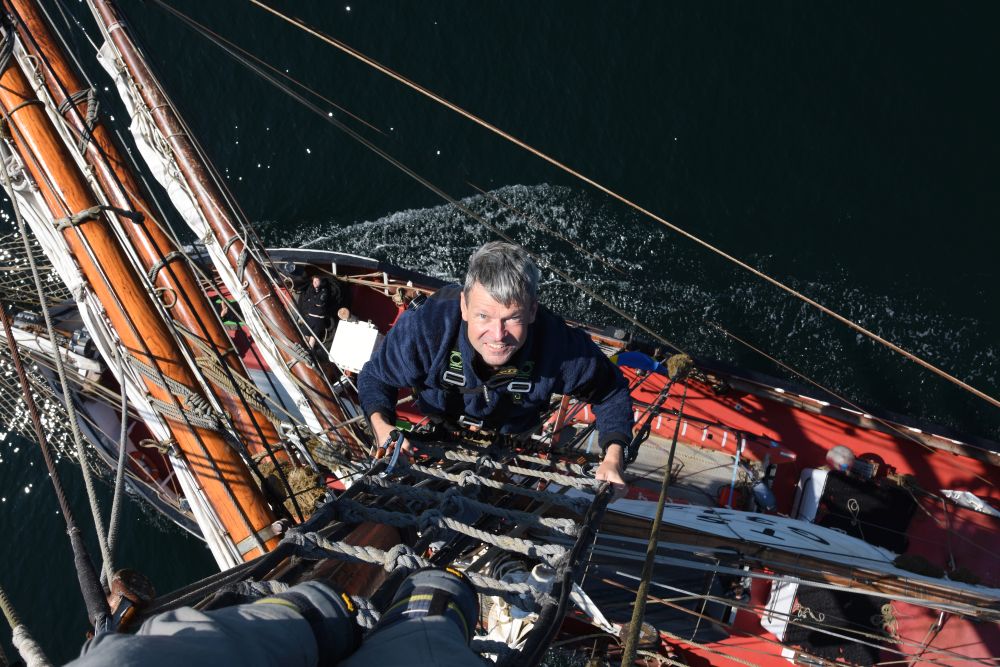Furthering science at sea
The first leg of Science Sets Sail is now over, we docked in Riga, Latvia, and welcomed guests to a special ‘Captain’s Dinner’ and our second ‘Open Ship Day.’ You might be wondering what we’ve achieved from a scientific perspective? Before changing crews, we asked this of Prof. Dr. Axel Munnecke of GeoZentrum Nordbayern.
How were the teams organised day to day?
The three teams – GZN, CHREN and FAPS – work together twice a day for four hours during the watch periods. These each last from 12:00-16:00 / 00:00-04:00; 16:00-20:00 / 04:00-08:00; and 20:00-00:00 / 08:00-12:00. In the meantime, there are also team sessions about sailing theory and tying knots, and the so-called ‘happy hour’ is completed. There are no cocktails! Instead, for a few days each member of the watch is assigned a task like toilet and shower cleaning, sweeping the dining hall and corridors, or polishing the brass.

How intensive is your contact within your watch?
I’ve had the chance to speak intensively with Tais Dahl, whom I had previously only known about via publications. We’ve shared insights from our projects, and could explain a lot to each other. In another example, Sylvain Richoz researches coccoliths from the Triassic period. These tiny coccoliths are single-celled algae and have a lime skeleton, that is, when they die, the skeleton remains as a fossil. There are now different ways to prepare the rock samples. I’ve investigated lime samples using a different method and have accidentally encountered coccoliths. On the ship, we talked about this. Now Sylvain will also apply this different method to his samples. In addition, on board we have two hours of team time each day during which we sit down and talk about each other’s projects, ask questions and make suggestions.
Are the three different teams spread across the three watch parties – does inter-group exchange suffer?
Both options would have advantages: ‘same-team’ or ‘mixed-team’ watch parties. If the teams work together on board, the professional exchange in specific fields will become more intense. If the focus is on cross-disciplinary contact, then of course mixed teams would be better. But it is also good to see hierarchies broken down, because everyone helps with all tasks on board.
Isn’t it enough for professional exchange to take place via e-mail, telephone or conferences?
Here on the ship we simply have more time, it is far more relaxed than, for example, on telephone conference call, especially if you’ve never met before or just met briefly at a lecture or a conference. Except for Tais, none of the geologists had been on such a sailing ship before. However, for geologists its not unknown to have such informal contact – we often have field trips during conferences, where opportunities for collaboration have already resulted in several projects.
What about your contact with the other teams?
At first, I thought that the technical link with geology would be closer to FAPS engineers than to human rights researchers. However, we’ve found that there are interesting intersections with the the CHREN team too. For example, Christoph Beier raised the question of the exploitation of cross-border deposits at sea, or those in international waters in the context of international and human rights issues – an exciting field that we’ve discussed a lot onboard! Even if we can’t finish the discussions on the ship, we’ve agreed that we will meet in Erlangen as soon as we’ve all looked more closely at the topic.
What else do you take with you from the voyage?
Many great memories of sailing, new contacts, and the knowledge of how important it is to be open to new things. One phrase I’ve used a lot is: “That’s interesting – tell me more.”






